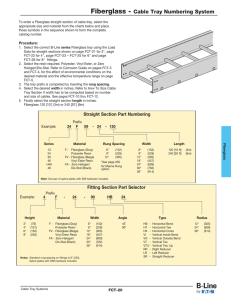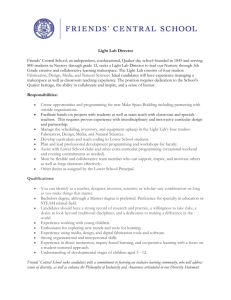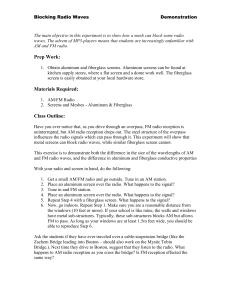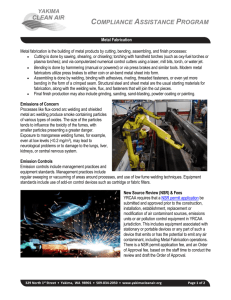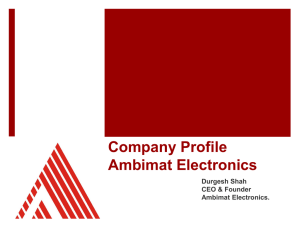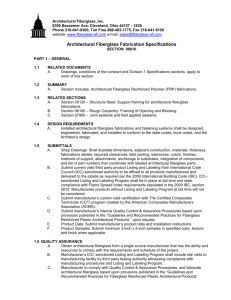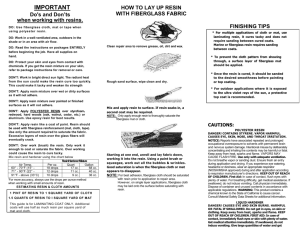NOV Fact Sheet - Yakima Regional Clean Air Agency
advertisement
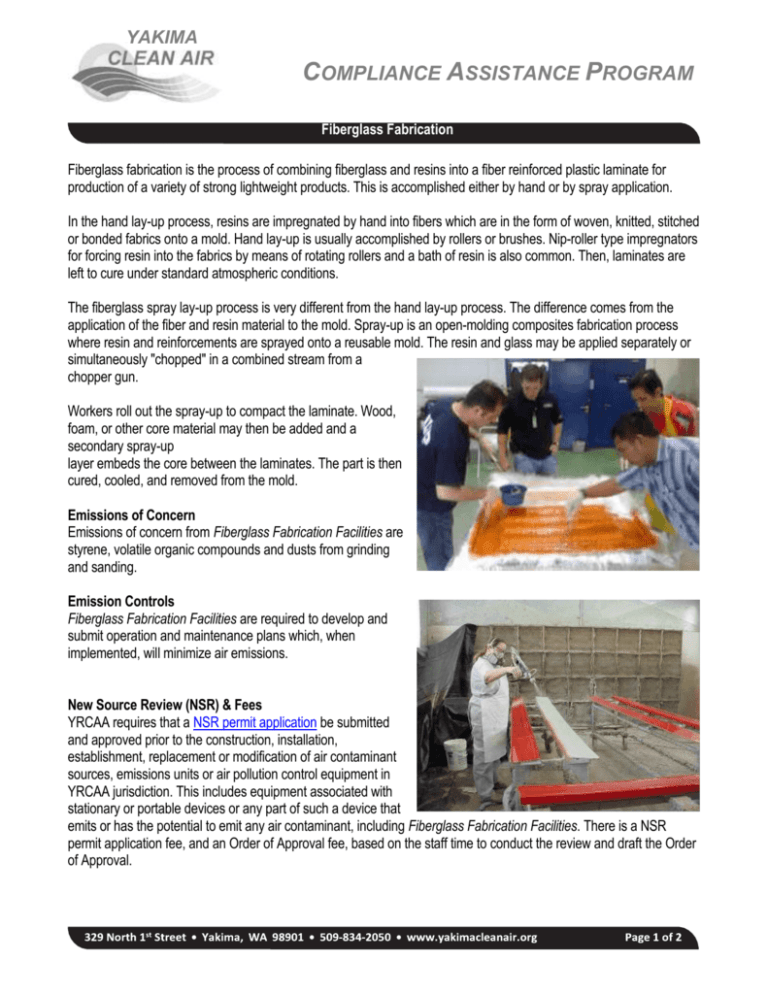
YAKIMA COMPLIANCE ASSISTANCE PROGRAM Fiberglass Fabrication Fiberglass fabrication is the process of combining fiberglass and resins into a fiber reinforced plastic laminate for production of a variety of strong lightweight products. This is accomplished either by hand or by spray application. In the hand lay-up process, resins are impregnated by hand into fibers which are in the form of woven, knitted, stitched or bonded fabrics onto a mold. Hand lay-up is usually accomplished by rollers or brushes. Nip-roller type impregnators for forcing resin into the fabrics by means of rotating rollers and a bath of resin is also common. Then, laminates are left to cure under standard atmospheric conditions. The fiberglass spray lay-up process is very different from the hand lay-up process. The difference comes from the application of the fiber and resin material to the mold. Spray-up is an open-molding composites fabrication process where resin and reinforcements are sprayed onto a reusable mold. The resin and glass may be applied separately or simultaneously "chopped" in a combined stream from a chopper gun. Workers roll out the spray-up to compact the laminate. Wood, foam, or other core material may then be added and a secondary spray-up layer embeds the core between the laminates. The part is then cured, cooled, and removed from the mold. Emissions of Concern Emissions of concern from Fiberglass Fabrication Facilities are styrene, volatile organic compounds and dusts from grinding and sanding. Emission Controls Fiberglass Fabrication Facilities are required to develop and submit operation and maintenance plans which, when implemented, will minimize air emissions. New Source Review (NSR) & Fees YRCAA requires that a NSR permit application be submitted and approved prior to the construction, installation, establishment, replacement or modification of air contaminant sources, emissions units or air pollution control equipment in YRCAA jurisdiction. This includes equipment associated with stationary or portable devices or any part of such a device that emits or has the potential to emit any air contaminant, including Fiberglass Fabrication Facilities. There is a NSR permit application fee, and an Order of Approval fee, based on the staff time to conduct the review and draft the Order of Approval. • • • YAKIMA COMPLIANCE ASSISTANCE PROGRAM Annual Registration & Fees Sources of air contaminants, including Fiberglass Fabrication Facilities, must register annually with YRCAA and pay a fee. YRCAA’s Board of Directors reviews fees annually. For current fees click here. As a part of the registration program, businesses are required to complete and submit a registration form annually. The annual registration program enables YRCAA to classify sources and maintain an inventory of air contaminants. Information is also used to evaluate air pollution control strategies to attain and maintain National Ambient Air Quality Standards. Inspections Regular inspections of registered sources are conducted to verify compliance with air pollution regulations. When inspecting Fiberglass Fabrication Facility, the compliance team will: review records; determine if any changes have been made to processes, equipment or materials; observe operation and maintenance activities; determine if any violations of rules, permits or orders exist; and determine if any corrective actions are needed to avoid enforcement. If you have already installed a Fiberglass Fabrication Facility or have installed or modified a process or any equipment within a Fiberglass Fabrication Facility, or are planning to in the future, please contact YRCAA. Our staff is available to assist you with the permit and registration process. YRCAA Rules YRCAA Regulation 1, Subsection 4.01 State Rules WAC 173-400 - General Regulations for Air pollution Sources Federal Rules EPA has rules for control of hazardous air pollutants (HAPs) called maximum achievable control technology (MACT) standards. To determine if your facility, equipment or operation is subject to a MACT standard see the following links: http://www.epa.gov/airtoxics/mactfnlalph.html http://www.epa.gov/ttn/atw/area/compilation.html • • •
